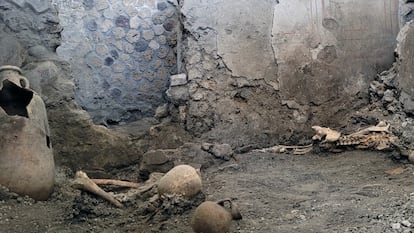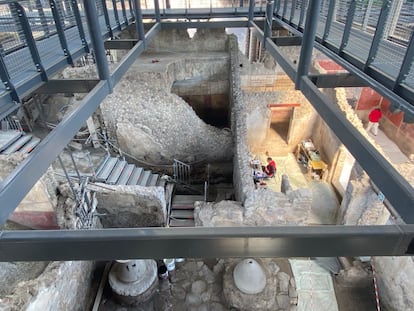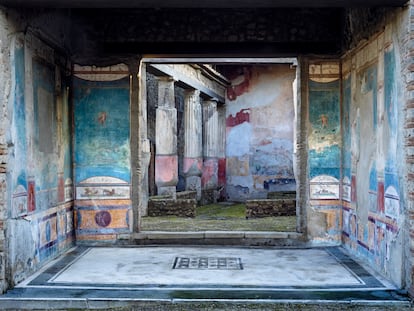While the volcano erupted, Pompeii was also struck by an earthquake
A new study has shed light on an overlooked factor that played a key role in the destruction of the city: earthquakes

New insight continues to emerge from Pompeii, the heritage-listed archaeological site near Naples, in Italy. While it may seem unbelievable, there is still more to learn about what happened during those two fateful days in 79 AD, when Mount Vesuvius erupted and the city was covered with a three-meter layer of lava and ash.
A study published in the journal Frontiers in Earth Science — which reconstructs the story of two Pompeiians who managed to escape the first phase of the eruption — has shed light on an overlooked factor that played a key role in the destruction of the city. Mount Vesuvius was not just to blame for the carnage: the residents of Pompeii were also struck by a series of earthquakes. The researchers point to the case of the two Pompeiians, who survived the eruption, only to be crushed to death by the rubble in the midst of the earthquakes. Since ancient times, it was known that Pompeii had been hit by simultaneous earthquakes, but there was no scientific evidence on how they affected the catastrophe. Now, for the first time, there is.
“We had a partial view of the destruction of Pompeii,” two of the authors of the study, Valeria Amoretti, a physical anthropologist and head of the Research Laboratory at the Archaeological Park of Pompeii, and Domenico Sparice, from the National Institute of Geophysics and Volcanology, tell EL PAÍS. Another five experts from both organizations (Fabrizio Galadini, Mauro A. Di Vito, Antonella Terracciano, Giuseppe Scarpati and Gabriel Zuchtriegel) took part in the project, the findings of which were announced in May. “The novelty is that, for the first time, the damage and victims of seismic activity during the course of the eruption have been recognized with certainty. Before now, the destruction of Pompeii had been attributed solely to volcanic phenomena […] Seismic activity certainly played an important role, especially between the first and second phase of the eruption, when the most violent earthquakes occurred,” they explain by email.
It was a perfect trap for the residents of Pompeii, worse than any disaster movie. The eruption began at 1 p.m. with a seven-hour shower of white pumice, which changed to gray pumice at 8 p.m., and lasted until 7 a.m. of the following day. Many residents — like the two who were the subject of the study — chose to take refuge in their houses, and in some cases the roofs collapsed under the weight of the volcanic debris. Traditionally, the Pompeiians found dead in houses were thought to have been killed for this reason. However, the case of these two residents indicates that some buildings resisted, but that from that night onwards, there were several earthquakes. The two Pompeiians in the study survived the eruption, but perished among the collapsed walls.
The following day, the Pompeiians who had managed to save themselves and get out of their houses were surprised by a final wave of lava; these were the people whose bodies were found in the streets. Unraveling this chain of events has been very difficult, because the outcome of those two hellish days — a mass of rubble, lava, ash and buried bodies — has made it hard to decipher the precise order in which things happened.
It was known that there were earthquakes on the day of the eruption. Pliny the Younger wrote in one of his letters to Tacitus that one was felt during the night of the first day (“It was so particularly violent that night that it not only shook but actually overturned”), and as well as at dawn on the second day: “The day begins, with a still hesitant and almost lazy dawn [...] The carts that we had ordered brought were moving in opposite directions, though the ground was perfectly flat, and they wouldn’t stay in place even with their wheels blocked by stones.”

If Pliny had mentioned it, why hadn’t it been taken into account until now? “During an eruption, volcanic and seismic phenomena can occur rapidly, or simultaneously. This can make it very difficult to correctly interpret the cause of the damage, because volcanic phenomena can mask or erase the evidence,” explain Amoretti and Sparice. But the fact that lava engulfed the city amid the chaos has helped the researchers: “Pyroclastic deposits, engulfing the buildings, freeze the exact moment of destruction and related evidence, protecting them from further break-up due to any type of decay,” the study states.
One of those scenes frozen in time — and thus providing an opportunity to dissect the timeline of events — was found in a house called Insula dei Casti Amanti (Insula of the Chaste Lovers), which was located in the central part of Pompeii. “The idea was born during the latest excavations, where we found structural damage with characteristics very different from the typical damage attributed to the impact of volcanic phenomena and described in the literature of Pompeii,” the researchers say. Two bodies stood out in particular. “The discovery of two skeletons, directly under two large fragments of wall, prompted us to undertake a multidisciplinary investigation that, for the first time, has involved an expert in so-called archaeoseismology, which determines the effects of ancient earthquakes.”
Creating a team of experts from various disciplines — archaeologists, volcanologists, anthropologists — was key to the study, and is increasingly common in research in Pompeii: “Multidisciplinary studies are essential in these contexts, because only by considering different perspectives is it possible to correctly assess the cause-effect relationship.”
After two months of work on the ground and seven months of analyzing the data — the volcanic strata, the walls of the buildings and the injuries that the two bodies presented — the researchers were able to determine that the walls collapsed due to an earthquake, not from being swept away by the lava, and that these two people were crushed to death, not suffocated or burned. In fact, the bodies were found on a layer of gray pumice from the first eruption, which had entered the house through a window from an alley. The home had already cooled, because there are no remains of charred wood. According to the research, these two Pompeiians survived the whole night in the room until dawn, when an earthquake struck, and toppled the walls, which crushed them to death.
“New perspectives of research”
“Our results represent a starting point for an updated view of the destruction of Pompeii [...] and open new perspectives of research,” the study concludes. In other words, the study encourages new thinking on how the Pompeians died. Earthquakes, they conclude, “should be regarded as an additional cause of death in the ancient Pompeii other than those reported in literature.”
According to studies, a total of 394 bodies were recovered from the pumice stratum that formed with the first phase of the eruption. Of these, 345 were found inside houses. Until now, it was believed these people died because the roof collapsed under the weight of the volcanic material. The new study, however, indicates that this may not have been the case for all deaths.
The study also indicates that the earthquake “probably also played a role in the choices made by the victims of the second phase of the eruption.” In other words, it influenced how people behaved, a factor that had not been taken into account until now. In the chaos of that tragic day, the decisions made by the Pompeiians marked their fate. A total of 650 bodies were recovered from pyroclastic flow deposits, both in houses and on the streets. One hypothesis is that the survivors of the first hours abandoned their houses or shelters during the pauses in volcanic activity. Another is that some of the survivors, who had fled at the beginning, tried to return to recover their belongings, thinking that the disaster was over. But the Frontier study suggests that the earthquakes drove the survivors in Pompeii to flee their homes, and likely discouraged others from returning home. Unfortunately, everyone on the street was killed by the lava flow.
The Pompeiians were used to earthquakes. Several had been documented in earlier years. For example, one in 64 hit while Nero was performing in a theater in Naples, according to Suetonius and Tacitus. But the biggest earthquake took place in 62. It wreaked so much damage that it is believed that repair work was still being done in Pompeii 17 years later, when Vesuvius erupted. In many houses, archaeologists found furniture pushed into corners, piles of lime, carefully stacked building materials and incomplete wall decorations. In other words, earthquakes were common in Pompeii, but on that occasion, they happened at the worst possible time.
Sign up for our weekly newsletter to get more English-language news coverage from EL PAÍS USA Edition
Tu suscripción se está usando en otro dispositivo
¿Quieres añadir otro usuario a tu suscripción?
Si continúas leyendo en este dispositivo, no se podrá leer en el otro.
FlechaTu suscripción se está usando en otro dispositivo y solo puedes acceder a EL PAÍS desde un dispositivo a la vez.
Si quieres compartir tu cuenta, cambia tu suscripción a la modalidad Premium, así podrás añadir otro usuario. Cada uno accederá con su propia cuenta de email, lo que os permitirá personalizar vuestra experiencia en EL PAÍS.
¿Tienes una suscripción de empresa? Accede aquí para contratar más cuentas.
En el caso de no saber quién está usando tu cuenta, te recomendamos cambiar tu contraseña aquí.
Si decides continuar compartiendo tu cuenta, este mensaje se mostrará en tu dispositivo y en el de la otra persona que está usando tu cuenta de forma indefinida, afectando a tu experiencia de lectura. Puedes consultar aquí los términos y condiciones de la suscripción digital.
More information
Archived In
Últimas noticias
Chris Martin, Taylor Swift, Elijah Wood and other famous wedding ‘crashers’
‘How does it feel to be a failure?’: Elizabeth Berkley’s journey from ‘Showgirls’ ridicule to vindication
The story of the Málaga virus: The code that haunted Google’s cybersecurity center director for 30 years
The impact of Ecuador’s mega-prison: A polluted river, cleared forests and military checkpoints
Most viewed
- Christian Louboutin: ‘Young people don’t want to be like their parents. And if their parents wear sneakers, they’re going to look for something else’
- The low-cost creative revolution: How technology is making art accessible to everyone
- All the effects of gentrification in one corner of Mexico’s Colonia Roma
- Liset Menéndez de la Prida, neuroscientist: ‘It’s not normal to constantly seek pleasure; it’s important to be bored, to be calm’
- December Social Security and SSI payments: Dates, double checks and the 2026 COLA increase











































